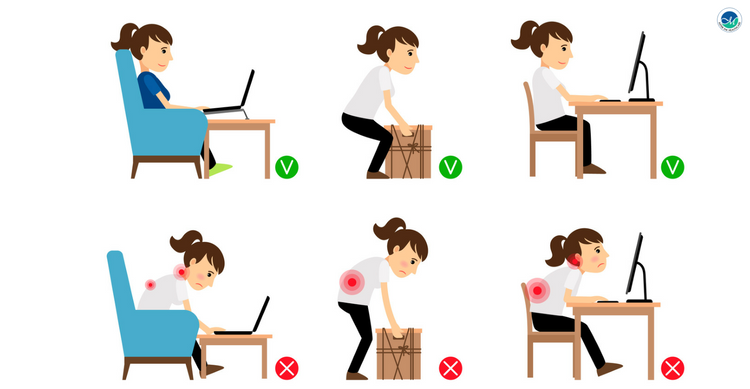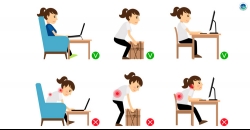
Body mechanics is a term used to describe the ways we move as we go about our daily lives. It includes how we hold our bodies when we sit, stand, lift, carry, bend, and sleep. Poor body mechanics are often the cause of back problems. When we don’t move correctly and safely, the spine is subjected to abnormal stresses that over time can lead to degeneration of spinal structures like discs and joints, injury, and unnecessary wear and tear.
Standing
Millions of people spend a good deal of their time on their feet. Standing work, including bending, lifting, carrying and reaching can be tough on the back – especially if proper body mechanics are not being used. Use the following guidelines to minimize the risk of injury to your back when working while standing.
- Avoid standing in one position for prolonged periods of time. Change your position as often as you can. This will not only help relieve stress on your spine, it also helps increase circulation and decrease muscle fatigue. When you can, stretch. Gentle stretching exercises during a break can help ease muscle tightness.
- Make sure the surface you are standing on is firm and level.
- If possible, lean on a solid support. This can help reduce fatigue during long periods of standing.
Sitting
Whether sitting at a desk or at home watching television, good body mechanics are still important to keep in mind. For prolonged periods of sitting, make sure you have enough support for your lower back. Look for a chair that has adjustable lumbar support. If that is not possible, you can increase your back support by using a lumbar roll or even a rolled up towel or cushion placed behind your lower back.
For deskwork, consider investing in an ergonomically enhanced chair. If your chair has armrests, make sure they are positioned to support the weight of your arms.
- Place your buttocks at the back of the seat while maintaining a small space between the back of your knees and the seat of the chair.
- Place your feet flat on the floor with your knees bent at a 90-degree angle.
- Pull your shoulders back and lift your chest.
- Lift your chin until it is level and relax your jaw and mouth.
Sleeping
We spend about one-third of our time in bed, so we can’t ignore how our bodies are positioned during sleep. As during our waking hours, the goal is to maintain a neutral spine even while we are in bed.
- Make sure you are sleeping on a firm mattress.
- Avoid sleeping on your stomach or with your head elevated on an oversized pillow. These positions cause the back to arch and place stress on the spine.
- The side and back are the best positions for maintaining a neutral position and a must for anyone with back or neck problems.
- Place a pillow between your knees (for side sleeping) or behind your knees (for back sleeping). This will help keep your spine in the right position and help ease stress on the lower back.
- Use a pillow that allows you to keep your head aligned with the rest of your body. Numerous and/or oversized pillows may look great on a made bed but do not necessarily benefit your back while sleeping

